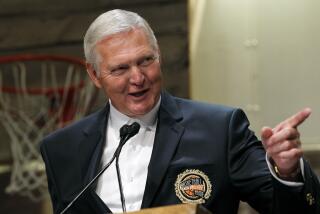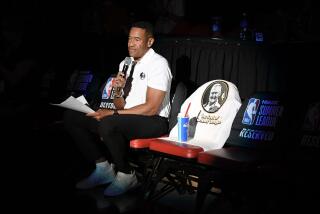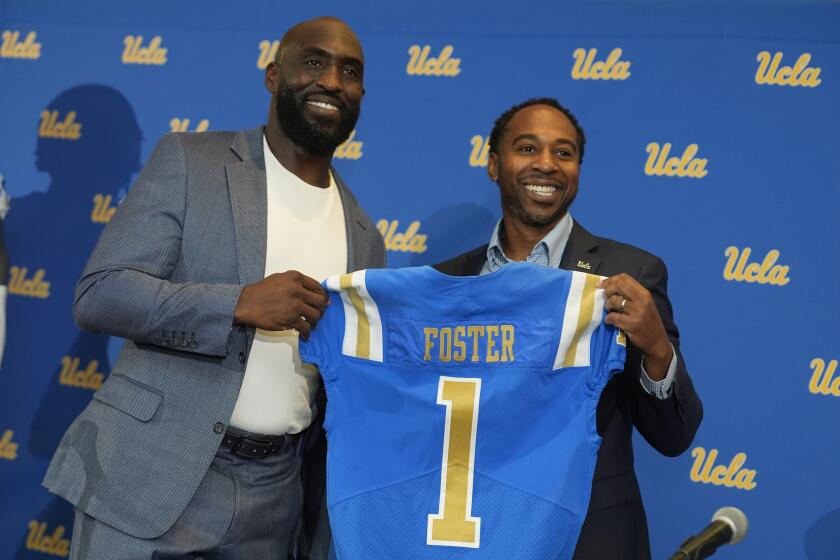That iconic NBA silhouette can be traced back to him
NEW YORK — Jerry West claims he’s not so presumptuous as to assume his image is depicted on one of the most recognizable emblems in sports: the NBA logo.
The NBA too is coy.
Alan Siegel is not.
“It’s Jerry West,” he says.
Siegel, 71, designed the familiar logo in 1969, taking a Wen Roberts photograph of the Lakers star and turning it into an iconic image.
In red, white and blue, it shows a player in silhouette purposefully dribbling the ball upcourt with his left hand.
Siegel, a branding expert and lifelong basketball fan, believes he knows why the NBA is reluctant to acknowledge the obvious.
“They want to institutionalize it rather than individualize it,” he says during an interview over lunch near his office in the Chelsea neighborhood of Manhattan. “It’s become such a ubiquitous, classic symbol and focal point of their identity and their licensing program that they don’t necessarily want to identify it with one player.”
NBA Commissioner David Stern, through a spokesman, declines to comment, saying he doesn’t know whether West is on the logo.
“There’s no record of it here,” spokesman Tim Frank says.
Siegel’s original artwork has been lost over the years through several office moves, but the designer recites the story of the logo in detail. In 1969, Siegel and his business partner, the late Robert Gale, opened their branding consultancy.
In a previous job, Siegel says, he oversaw development of Major League Baseball’s logo, which was developed in 1968 and introduced during baseball’s centennial in 1969. It too is red, white and blue and features a player -- a batter -- in silhouette.
It’s no accident, Siegel notes, that the logos are similar.
He says that J. Walter Kennedy, the NBA’s commissioner from 1963 to 1975, told him that “he basically wanted to have a family relationship with baseball and to use red, white and blue to position basketball as an All-American game.”
Siegel says he came up with 40 or 50 designs, none of which featured any players other than West, but Kennedy gravitated toward the derivative of the baseball logo.
“And in those days,” the designer says, “it was top down. He made the decision. There was no research. There was no discussion. He said, ‘We’re doing this.’ ”
Siegel, 6 feet 2, was a star basketball player at Long Beach High on Long Island. He says he turned down dozens of basketball scholarships to attend Cornell, where he left the basketball team after one season to concentrate on academics.
A childhood friend, the late sportswriter and broadcaster Dick Schaap, also was a Cornell graduate. And later, when Siegel was searching for an image to use in the NBA logo, Schaap gave him access to the photo archives at Sport magazine.
“I found this picture of Jerry West dribbling down the court,” Siegel says, “and, of course, growing up in New York and my father having season tickets for college and pro games at Madison Square Garden, I’d seen West play a lot.”
West, in fact, was one of Siegel’s favorite players -- along with John Havlicek and Oscar Robertson -- but that’s not why he chose to feature the former West Virginia star in his design.
The photo, Siegel says, just grabbed him.
“It had a nice flavor to it,” he says, “so I took that picture and we traced it. It was perfect. It was vertical and it had a sense of movement. It was just one of those things that clicked.”
Kennedy thought so too.
“Nobody else said anything,” Siegel says. “And when we did the publicity, nobody ever asked whether it was Jerry West.
“If you did it today, they’d want 50 designs. They’d get focus groups and test it. They’d make a whole big deal about it and they’d probably end up with a design that wasn’t as good.”
West, calling it “awkward” to comment on the logo when the NBA won’t confirm he’s on it, remembers thinking when he first saw Siegel’s design, “That looks like somebody familiar.”
Siegel, a Knicks season-ticket holder for more than 30 years, says he twice met West, once at a restaurant in Los Angeles and more recently at a Lakers game at Staples Center.
At the restaurant, Siegel says, “I introduced myself and told him I’d designed the logo. And he said, ‘Who was the commissioner then?’ I said, ‘Kennedy,’ and he said, ‘OK,’ and went on with his lunch.”
At the game, “he was sort of friendly but noncommittal, so he’s never really said anything to me about it,” Siegel says.
In a new biography, “Jerry West: The Life and Legend of a Basketball Icon,” it’s noted that West is not above jokingly introducing himself by saying, “I’m the logo.”
Today, he demurs: “If that’s me, I’m extremely flattered.”
But of course it’s him.
In recent years, some have suggested that the logo be updated, that perhaps it should feature Michael Jordan.
“Fine with me,” West says.
Siegel says no.
“I’m a fairly sophisticated marketing guy,” he says, “and I think something that’s so well-known and symbolic of high-level basketball around the world, it would be a mistake to change it.
“It has significance and appeal because it’s historical. It doesn’t look like a modern player. It’s a classic image.”
More to Read
Go beyond the scoreboard
Get the latest on L.A.'s teams in the daily Sports Report newsletter.
You may occasionally receive promotional content from the Los Angeles Times.










